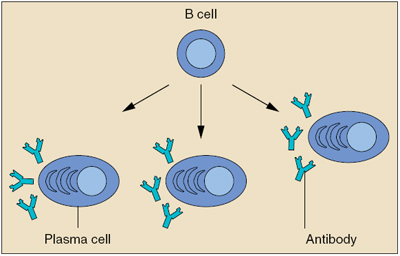B Cells
B cells and T cells are the main types of lymphocytes. B cells work chiefly by secreting substances called antibodies into the body’s fluids. Antibodies ambush foreign antigens circulating in the bloodstream. They are powerless, however, to penetrate cells. The job of attacking target cells—either cells that have been infected by viruses or cells that have been distorted by cancer—is left to T cells or other immune cells (described below).Each B cell is programmed to make one specific antibody. For example, one B cell will make an antibody that blocks a virus that causes the common cold, while another produces an antibody that attacks a bacterium that causes pneumonia. When a B cell encounters the kind of antigen that triggers it to become active, it gives rise to many large cells known as plasma cells, which produce antibodies.
- Immunoglobulin G, or IgG, is a kind of antibody that works efficiently to coat microbes, speeding their uptake by other cells in the immune system.
- IgM is very effective at killing bacteria.
- IgA concentrates in body fluids—tears, saliva, and the secretions of the respiratory and digestive tracts—guarding the entrances to the body.
- IgE, whose natural job probably is to protect against parasitic infections, is responsible for the symptoms of allergy.
- IgD remains attached to B cells and plays a key role in initiating early B cell responses.

B cells mature into plasma cells that produce antibodies. View credit information.
back to top